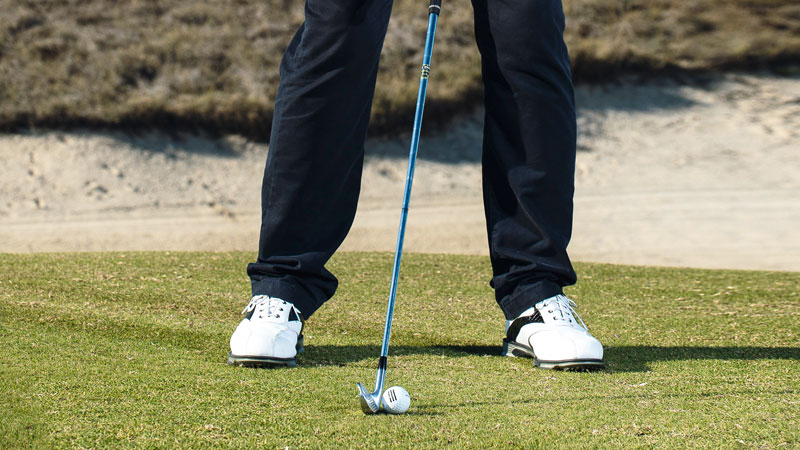How To Play The Low Punch Shot
In this video and article, two of Golf Monthly's Top 50 coaches discuss how to play the low punch shot


There are two ways to play the low punch shot in golf - ball back or weight forward. In the video and article below, we take a look at the specifics to help you control your ball flight, especially in the wind.
This video from Golf Monthly Top 25 Coach Clive Tucker offers a great explanation for how to play the low punch shot. However, to offer as much insight as possible we have added the advice from another Golf Monthly Top 5o coach, Peter Dawson - below.
1. Take your pick
The low punch shot is a great one to have in your locker when you’re looking for more control or a lower flight, perhaps when playing in to a strong wind. There are two trains of thought here. One is that you put the ball back in your stance.

The other is that you leave everything as normal at address, grip down the club two or three centimetres, put 60-65% of your weight on to your front foot and swing as normal, leaving the weight there during the swing. I prefer the latter, but will talk through both.
2. Club up
Whichever option you go for, you must hit more club that you would normally for whatever distance you have. If I’m 150 yards from the green, I would perhaps choose a 6-iron rather than a 7-or maybe 8-iron. This will ensure that you are able to make a controlled swing, keeping the amount of backspin you create down whilst still ensuring you're able to reach your target.
As a rule of thumb, I would say no more than one club up if you opt to move the ball back in your stance, but one or two clubs if you opt to keep more of your weight forward throughout the swing.
RELATED: Why Do I Pull Iron Shots?
Subscribe to the Golf Monthly newsletter to stay up to date with all the latest tour news, equipment news, reviews, head-to-heads and buyer’s guides from our team of experienced experts.
3. Weight forward
If you go for my preferred ‘weight forward’ approach, nothing changes at first in terms of posture. Take up your normal address position, then rock slightly on to your front foot such that you have 60 to 65 per cent of your weight there. Crucially, your weight should remain there throughout your backswing rather than transferring on to your back foot as in a normal full swing.
This allows the swing to become a little more vertical going back, enabling you to bring the club back into the ball on a steeper path and helping you to punch it away on a lower trajectory. Gripping down the club a few centimetres will bring added control and further enhance that fractionally more vertical swing.
RELATED: Best Golf Irons
4. Ball back in stance
Again, nothing really changes in terms of posture – all you need to do is move the ball back in your stance to just behind the central position. This reduces the loft to help you find a lower, more controlled flight, but beware that this can also increase the possibility of the clubface opening a little. Try it on the range first before heading to the course - if you are hitting pushes, simply aim a fraction further left than you usually would. From here, just swing as normal.
RELATED: How To Stop Pushing Iron Shots
5. Not too short
Most golfers know that the swing should be shorter with a punch, but I would guard against making it too, too short as that can throw your tempo out.
I think many golfers don’t swing back far enough when punching the ball, so I would recommend a three-quarter length backswing with a good shoulder turn. Think of a pendulum as you then punch the ball away and follow through to the same length as your backswing. This should be a more compact version of your usual swing and it will help to take out a little backspin through impact to keep the flight down.

Jeremy Ellwood has worked in the golf industry since 1993 and for Golf Monthly since 2002 when he started out as equipment editor. He is now a freelance journalist writing mainly for Golf Monthly. He is an expert on the Rules of Golf having qualified through an R&A course to become a golf referee. He is a senior panelist for Golf Monthly's Top 100 UK & Ireland Course Rankings and has played all of the Top 100 plus 91 of the Next 100, making him well-qualified when it comes to assessing and comparing our premier golf courses. He has now played 1,000 golf courses worldwide in 35 countries, from the humblest of nine-holers in the Scottish Highlands to the very grandest of international golf resorts. He reached the 1,000 mark on his 60th birthday in October 2023 on Vale do Lobo's Ocean course. Put him on a links course anywhere and he will be blissfully content.
Jezz can be contacted via Twitter - @JezzEllwoodGolf
Jeremy is currently playing...
Driver: Ping G425 LST 10.5˚ (draw setting), Mitsubishi Tensei AV Orange 55 S shaft
3 wood: Srixon ZX, EvenFlow Riptide 6.0 S 50g shaft
Hybrid: Ping G425 17˚, Mitsubishi Tensei CK Pro Orange 80 S shaft
Irons 3- to 8-iron: Ping i525, True Temper Dynamic Gold 105 R300 shafts
Irons 9-iron and PW: Honma TWorld TW747Vx, Nippon NS Pro regular shaft
Wedges: Ping Glide 4.0 50˚ and 54˚, 12˚ bounce, True Temper Dynamic Gold 105 R300 shafts
Putter: Kramski HPP 325
Ball: Any premium ball I can find in a charity shop or similar (or out on the course!)